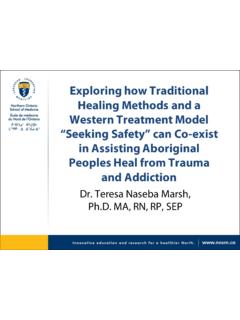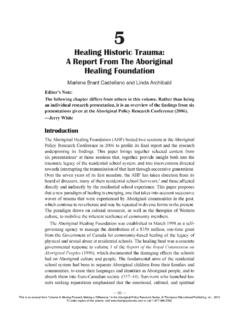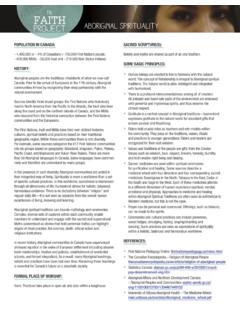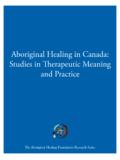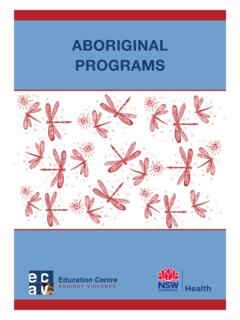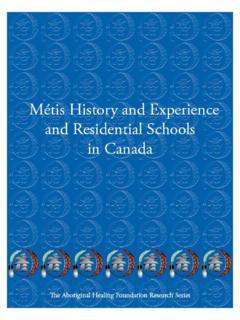Transcription of Mental Health and Suicide in Indigenous Communities in …
1 1 Mental Health and Suicide in Indigenous Communities in canada Ryan Giroux, University of Toronto, National Officer of Indigenous Health 2014-2016 Kai Homer, University of Alberta Shez Kassam, University of Alberta Tamara Pokrupa, University of Ottawa Jennifer Robinson, McGill University Amanda Sauv , Western University, National Officer of Indigenous Health 2016-2017 Alison Sumner, University of Toronto 2 Problem History canada s Indigenous population, including First Nations, Inuit, and M tis people, comprises of the general population. Despite representing a fraction of the population, the Suicide rate among Indigenous youth aged 15-24 is 5 to 6 times the rate seen in the general Canadian population; this rate is especially high among Inuit youth, at 11 times the national average.
2 (1,2) Suicide and self-inflicted injury is the leading cause of death among First Nation youth aged 15-24, whereas in the general youth population it is accidental death.(2) An example which speaks to the urgency of this issue is the number of Suicide attempts in northern Communities , such as in the Attawapiskat First Nation in Ontario. In April 2016, the Attawapiskat First Nation declared a state of emergency for the escalating problem of youth Suicide in this region. Local and relief Health care workers responding to the situation were overwhelmed by this public Health crisis.(3) Suicide among Indigenous youth in canada is a nationwide crisis that has been brought to public attention not only by recent media coverage, but also declarations from individual Communities , and is apparent in national statistics dating back more than a decade.
3 (1,2) Despite this, Indigenous Communities have and continue to display resilience as shown through various community-led Suicide prevention initiatives. While Suicide is not a distinct psychiatric disorder, 98% of people who die by Suicide worldwide are believed to have a Mental illness.(4) Risk factors in the general population (including Indigenous peoples), include a previous Suicide attempt, a recent discharge from hospital, and a concurrent major depressive episode. Other risk factors include substance use, psychosis, lack of social supports and access to means.(5) With regard to Indigenous persons, the former National aboriginal Health Organization (NAHO) put forward specific risk factors for suicidal behaviour: predisposing factors, contributing factors, and precipitating factors.
4 Predisposing factors include engagement in self-harm, a personal history of a psychiatric disorder, and/or persons known to the individual including a family member, friend, or community member who have committed Suicide . Contributing factors include poor coping skills, limited social supports, financial difficulties, familial and interpersonal conflict, separation of child from family, abuse and unresolved grief. Precipitating factors that were identified include a recent move, a sudden loss or failure, and humiliation.(6) While these elements also constitute risk factors among the general population they are often more prevalent in certain Indigenous Communities due to factors such as small community size and deficits in infrastructure stemming from generations of neglect by the Federal Government and other parties, as described below.
5 It is worth noting that Suicide is not universally pervasive within Indigenous Communities . A strong sense of culture and ownership of community has been shown to be protective against Suicide and self-harm behaviours in some Communities .(7) A Regional Health Survey from 2002/2003 suggested that 70% of First Nations adults living on-reserve felt physically, emotionally, mentally, and spiritually balanced.(7) In addition to cultural aspects (which include language), other factors may protect against a heightened Suicide risk in First Nations Communities , such as job creation, employment, and opportunities for personal development (such as career training programs). (8) Despite the overall well-being of First Nations adults living on reserve, some Indigenous Communities remain extremely vulnerable to Mental illness and Suicide .
6 A cultural heritage of colonialism may play a role as evidenced by a substantial body of 3 qualitative research and a wealth of personal testimony, the now-defunct federal Indian Residential School System (created under direction of the Indian Act) left a legacy of physical and psychological trauma which has contributed to the disproportionately high Suicide rate seen in some Indigenous Communities .(9) Under the guise of formal education which has now been acknowledged to have been part of an assimilationist policy residential schools that were operated by various churches and the Federal Government of canada subjected Indigenous children to many forms of abuse, including verbal abuse, physical abuse, sexual abuse, and neglect.
7 (10) Factors including, but not limited to, poor sanitation, inadequate Health care, physical abuse as punishment, and malnutrition resulted in physical and Mental harm to students,which contributed to the high prevalence of psychiatric disorders among survivors.(11) To illustrate this point, The British Columbia aboriginal Survivor s study found that of 127 residential school survivors, only two were free of Mental illness.(12) The same study showed that of residential school survivors experience a major depressive episode, while experience chronic depression and experience repercussions from post-traumatic stress disorder.(13) The aforementioned psychiatric disorders are risk factors for Suicide in the general population.
8 (5) Intergenerational trauma, which refers to a process by which trauma and stress are passed down from generation to generation, is strongly linked to the residential school experience in canada .(6) A report prepared for the aboriginal healing Foundation summarizes aspects of the residential schooling system and how they contributed to a trauma cycle resulting in suicidal behaviours.(7) Furthermore, it is a well characterized phenomenon that adverse childhood experiences are associated with the development of Mental Health disorders and Suicide .(14 16) Multiple sources provide evidence of a long-standing history of sexual abuse in the residential school system, and it has been shown that the survivors of this abuse were more likely to become perpetrators of sexual abuse in the future (often in their home Communities ).
9 (13,17,18) The residential school system, and its associated physical and psychological abuses, cultural deprivation, and forced isolation of students from their homes and families, created a milieu for the traumatization of thousands of children directly or indirectly through intergenerational trauma. Mounting public knowledge and evidence of the failure of the residential school system led the Federal Government to phase out the program. (17) The decline in overt assimilationist policy gave way, however, to the Sixties Scoop , a multi-decade period in which thousands of Indigenous children were removed from their birth families and placed in the care of child welfare wards. (19) The highly disproportionate removal of Indigenous children by the child welfare system in the 1960s in comparison to non- Indigenous Canadian children initiated a trend which continues to this day.
10 A 2016 report from the Office of the Child and Youth Advocate regarding Indigenous child welfare in Alberta acknowledges that Indigenous children and families are overrepresented in every part of Alberta s child welfare system .(20) Previous reports from the Ministry of Children and Family Development in British Columbia, in addition to academic reviews have identified that Indigenous children are more often taken into care, remain in care longer, and are less likely to be reunited with their families.(21 23) The ongoing Indigenous child welfare crisis in canada destabilizes the psychological well-being of parents and child; children in the welfare system are in turn at an increased risk of Suicide .(21,24) 4 In 2015, the Truth and Reconciliation Commission (TRC) released a report summarizing the accounts of over 6,750 Residential School Survivors and provided recommendations on approaching its consequences.

